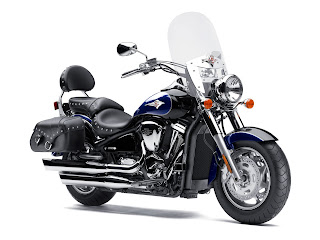2010 Kawasaki Vulcan 1700 Voyager ABS
2010 Kawasaki Vulcan 1700 Voyager ABS
Built for the touring rider who has to have it all—and look good having it…
Flagship of the Vulcan® 1700 family, the Kawasaki Vulcan 1700 Voyager® and Voyager ABS come equipped with everything the serious touring rider needs to pile on the miles in comfort and style: a large frame-mounted fairing, amazing storage capacity, a sculpted touring seat, electronic cruise control, a premium sound system and a powerful long-stroke 1700cc, liquid-cooled, 52° V-Twin engine.
For 2010, the Vulcan Voyager ABS’s complement of cutting-edge electronics is headlined by a new, second-generation version of the Kawasaki Advanced Coactive Braking Technology (K-ACT) system. Available on the ABS-equipped Voyager, K-ACT uses advanced electronics to translate the rider’s braking inputs into both the front lever and rear pedal into smooth, balanced deceleration and maximum stopping performance. Basically, the front lever also activates the rear brake, and the rear pedal also engages the right front caliper: K-ACT sees to it that that happens seamlessly and efficiently, and the new, second-generation system uses the same smaller, lighter ABS unit and the faster, higher-spec brake ECU found on the Kawasaki Concours™ 14 ABS motorcycle for even smoother, more precise operation. (Unlike the Concours 14 ABS, however, only a single K-ACT mode is available.) K-ACT’s coactive function does not engage when braking is initiated at speeds below 12 mph, and the ABS function is automatically disengaged at speeds below four mph.

















































.jpg)
.jpg)
.jpg)
.jpg)